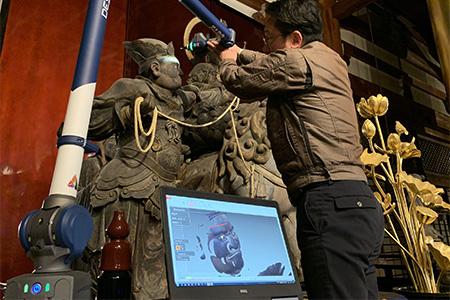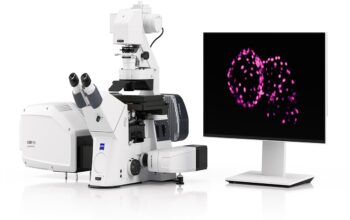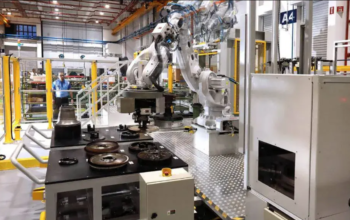“What should we do to preserve culture & history that have been handed down from our ancestors and to pass them down generations?” The answer to that led by KYOTO’S 3D STUDIO (Sakyo-ku, Kyoto, Japan, hereinafter referred to as KYOTO’S 3D STUDIO) was to edit and analyze the data obtained by 3D scanning technology and process them in various ways. KYOTO’s 3D STUDIO’s task is to transform scanned data into ones required to check and restore buildings or historical artifacts. Those data can be utilized in wide range of applications such as modeling or reverse engineering, 3D printing, CAD, maintenance and repair, overhaul, digital archives.
KYOTO’S 3D STUDIO acquires data mainly from intellectual properties such as world heritages, Japanese national treasures and important cultural properties. As none of them can be directly touched by hands, all data must be obtained using the non-contact measurement method. Therefore, FARO 8-Axis DesignScanArm 2.5C and Focus3D plays a very important role in.
A STRONG DESIRE IN PRESERVING BOTH INTERIOR AND EXTERIOR OF BUILDINGS
In the beginning, KYOTO’s 3D STUDIO was getting data mainly from buildings such as shrines and temples of world heritages, national treasures or cultural assets. Mr. Kazuya Nishimura, director of the company, recalled those days by saying, “People affected by the Kumamoto earthquake sought psychological support from local temples and shrines. Some people can be less energetic without them. Even though we wished to reconstruct them quickly, it was hard to do it as there were no original blueprint or data.
With the 3D scanning technology, we could keep artifacts as data in advance. That was the initial response to the problem.”
Soon after, interest and demand to preserve digital data not only for buildings but also artifacts inside them has increased. According to Mr. Nishimura, about 20 years ago, an extremely primitive method was mainly used to preserve data by comparing coordinate values obtained from a scanner in 3-4cm pitch with photos. “However, those artifacts with high cultural value must be scanned unde tight tolerance requirement. On top of that, we have time restrains,, so it also called for fast process speed.” explains Mr. Nishimura as he revealed his challenge and its meaning.

The statue of Buddha that is not allowed to bring out of temple can be scanned on the spot. With FARO Prizm scanner with green laser, represent the statue of Buddha in color.

The point cloud data of the face part. Gold foil of eyes and wood texture are well represented in color.
At that time, KYOTO’s 3D STUDIO used an old model of Design ScanArm that had 75μm tolerance but acquired data only in black and white, so they could not get enough information on the important parts such as grains of the wood carvings or scars. To reproduce them precisely as data, a good deal of time and cost was required to correct and adjust each of them by pasting color data from photos. On the other hand, FARO 8-Axis Design ScanArm 2.5C introduced recently can scan in color, so the data itself can stand as a complete replica of the actual artifact.
It is a huge advantage to in recreating details and colors of grains as vivid as they are when scanning natural treasures and cultural assets.
RECREATING SUBTLE TEXTURES AS THEY ARE
The advantage of color scan is not only in visualizing grains and scars but also in enabling the creation of an image of statue of Buddha itself and utilizing those data in a digital museum. Another function was 8-Axis mechanism which brought effects to increase the number of scan while significantly reducing operating time. “The advantage of this system is to utilize color scan and increase process speed. This eventually also leads to clients’ satisfaction. We cannot offer our customers anything that we are not sure about in terms of quality.” Mr. Nishimura evaluates FARO products as above. He also pays attention to the portability of FARO 8-Axis Design ScanArm 2.5C. “It is very helpful to obtain data on the spot as those precious artifacts are not easily brought outside. It makes data acquisition easier by reducing risks of damage during transport for both clients and workers as well as saving transport time.”

Scanning an old China bowl on the 8-Axis turn table using tool fabricated by themselves.
In fact, it is an inevitable function for KYOTO’s 3D STUDIO who pursues reality to obtain information including not only design and shape of the object but also texture as 3D data.
The reason why KYOTO’s 3D STUDIO is located in Kyoto is because about 70% of the important historical cultural assets are concentrated on western area of Japan including Osaka and Nara. As a matter of fact, there are many cultural assets that are hoped to be kept as digital archives one artifact that they were able to archive is the national treasure of the statue of Yakushi Nyorai. With FARO’s system, not only can we capture subtle textures but also the surface asperity on which gold foils are impressed upon, says Mr. Nishimura.
CLIENTS’ HAVE POTENTIAL OF USING 8-AXIS DESIGN SCANARM
From the cultural assets preservation point of view, those involved in shrines and temples became increasingly interested in the work of KYOTO’s 3D STUDIO using FARO system there are movements trying to prevent theft or support preservation through archiving or making replicas of obtained data. Projects to scan potteries such as excavated china bowls are also increasing. “For example, restore broken artifacts, we used to measure their thickness by hand. However, the complex design can be easily scanned in good accuracy including their size with the FARO 8-Axis Design ScanArm 2.5C,” explains Mr. Nishimura.
He also adds that it is possible to restore all the parts of a China bowl, only using the scanned data of the unbroken parts. Especially for China bowls, as they are many, we can quickly handle with 8-Axis turn table.” said by Mr. Nishimura.
KYOTO’s 3D STUDIO has grown with the scanning business at its core within a short period. In its foundation is a ‘commitment to fully support our customers create a new demand in scanning’. Mr. Nishimura expects his company’s future development by saying, “By taking advantage of the simpleness of editing 3D data on computer, we can easily utilize the data to promote digital tourism of famous cites and increase the number of visitors there and in museums. We would like to focus on scanning statues of Buddha and historical artifacts rather than buildings and gardens. Also, we are hoping to expand our business globally and recently recruited 2 members from overseas.

Animation work representing unique perspective of the world using 3D point cloud data. Thus, we can expect to utilize 3D data in a wide area.
KYOTO’s 3D STUDIO’s low key efforts can help stimulate interest in valuable intellectual properties including cultural assets. Mr. Nishimura concludes, “From now on, it all depends on how well we advertise ourselves.” We could find target audience within work scope of FARO scanner, which may lead to a new market development. In a nut shell, clients have the potential of finding a new usage of 3D data. Therefore, our future success depends on how much we can push ourselves to directly hear our customer voices such as “we want to use scanning this”. The vision drawn by Mr. Nishimura is very clear.









